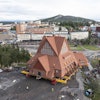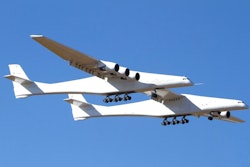Soft Robotics Enable VR Glove
Engineers at UC San Diego have developed a soft robotic glove that could lead to more lifelike experiences with virtual reality environments. It has flexible, soft robotic muscles that make you feel when you're pushing something in VR.
In their first prototype, the researchers used a soft robotic component called a McKibben muscle, which consists of latex chambers covered with braided fibers. The muscles respond like springs to apply force when the user moves their fingers, and custom fluidic control board inflates and deflates the muscles.
The system has three main components: the soft robotic components, the custom control board, and a Leap Motion sensor that detects your hand’s position and movement.
The researchers 3D-printed a mold to make the gloves’ exoskeleton, which could make the devices easier to manufacture and suitable for mass production. They also used silicone rubber for the exoskeleton, with Velcro straps embedded at the joints.
Their new system interacts with a virtual piano keyboard, and when they did an informal pilot study, they found two things. First, that the test subjects were not pianists. And second, that it made for a more immersive experience.
The engineers are now working to make the glove cheaper, more portable, and less cumbersome. They also want to bypass the Leap Motion device altogether.
Right now, the prototype is only playing the virtual piano, but is could soon be used for everything from training surgeons to video games.
NASA to Take Shot at the Sun
NASA is on a “mission to touch the sun,” or at least send a spacecraft closer than we ever have before. Renamed the Parker Solar Probe after Eugene Parker, a solar astrophysicist and professor emeritus at the University of Chicago, the spacecraft will fly within 4 million miles of the sun's surface, which is actually seven times closer than any previous mission. The spacecraft will experience heat and radiation unlike anything that a man-made structure has ever experienced before.
Until now, the materials to withstand such conditions didn't exist. The probe is going to travel 430,000 mph and reach spots with temperatures up to 2,500°F. The probe, which is about the size of a car, boasts a heat shield with a thermal protection system, and a solar array cooling system.
The hope is to study the sun's outer atmosphere and gain a better understanding of how stars work. They also want to know how the Sun’s corona is heated, the corona is the aura of plasma that surrounds the sun. They want to know more about solar flares that have the potential to knock out the satellites that keep our society connected.
Parker, who will be 90 in 9 days, is the first living person to have a NASA spacecraft named after him. In 1958, he predicted high speed solar wind, which is the stream of charged particles, or plasma, that flows from the sun out into space.
The targeted launch date is July 31, 2018 with the first close approach to the sun in November 2018.
Stratolaunch Rolls Out Massive Aircraft
For the first time ever, the massive Stratolaunch aircraft moved out of its hangar in Mojave, CA, to conduct aircraft fueling tests. The milestone means that the initial aircraft construction phase is over. I suppose that the occasion could’ve been marked when the team removed the three-story scaffolding surrounding the aircraft, and dropped the aircraft's full weight onto its 28 wheels, but this makes for a better (and safer) photo opp.
The aircraft has a wingspan of 385 feet (25 feet longer than a football field), which will make it the largest aircraft, by wingspan, to ever fly. Boeing’s new 787 Dreamliner, has a wingspan of 197 ft. The new craft is 238 feet from tip to tail, it's five stories tall, and it weighs 500,000 pounds. For perspective, take a look at that lift next to it, looks tiny. The craft is designed to carry payloads of up to 550,000 pounds.
In October, the company announced a multi-year partnership with Orbital ATK. The new craft will initially launch a single Orbital ATK Pegasus XL vehicle but it’s capable of launching up to three Pegasus vehicles in a single mission.
In a statement, Stratolaunch CEO Jean Floyd said that the company is on track to perform its first launch demonstration as early as 2019.
Stratolaunch was founded in 2011 by Microsoft co-founder Paul Allen. Allen's vision was to make it easy to access low Earth orbit to drive advancements in science, research, and technology. The initial aircraft concept design was the work of Burt Rutan, who is best known for designing SpaceShipOne.
This is Engineering By Design with David Mantey.






















